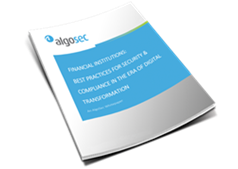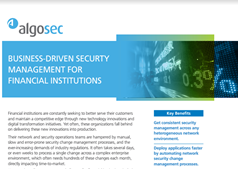Automated Security Policy Allows Financial Institutions to make the Triple Play


Financial institutions must contend with the big three challenges of digital transformation, cyberthreats and regulations.
Always seeking a competitive edge, financials invest heavily in digital transformation, especially customer-facing technology innovations, but delivery often trails behind the need. New apps are developed, but network security policy management is often perceived as holding up progress, hampered by manual and error-prone change-management processes.
Errors in network security management procedures also expose institutions to unreasonable levels of cyber risk.
The growing body of demanding regulations burdens financial institutions with severe compliance requirements and never-ending audits.
There must be a better way!
Our latest webinar shows financial institutions how to make the triple play by automating network security policy management changes, at once enabling the business, reducing risk and enforcing compliance.
In this webinar you will learn about:

Financial Institutions: Best Practices for Security & Compliance in the Era of Digital Transformation
Financial institutions face two major network security related challenges while working to serve their customers: the constant demand to improve in order to successfully compete in the market and regulatory compliance. Yet, when it comes to security, the InfoSec team often uses slow, manual (and error prone) processes to make the necessary network security changes - thereby delaying the release of a new competitive application or feature to market. To overcome these challenges, financial institutions must implement a network security policy management solution that will:

Business-Driven Security Management For Financial Institutions
Financial institutions are constantly seeking to better serve their customers and maintain a competitive edge through new technology innovations and digital transformation initiatives. Yet often, these organizations fall behind on delivering these new innovations into production.

Security policy management for financial institutions
Financial institutions are constantly seeking to better serve their customers and maintain a competitive edge through new technology innovations and digital transformation initiatives, yet they often fall behind on delivering these new innovations into production. Network and security operations teams are often hampered by manual, slow and error-prone security policy change management processes, and the ever-increasing demands of industry regulations. It often takes several days, or even weeks to process a single change across a complex enterprise environment, which often needs hundreds of these changes each month, directly impacting time-to-market. Geared towards the specific challenges of financial institutions, this webinar will provide technical best practices for managing network security policy changes while reducing risk and enforcing compliance and will cover: • Key industry metrics that compare security environments in and outside the finance industry. • The state of network security and management challenges • How to overcome security management complexity with automation • How to address the ever-increasing demands of the financial industry regulations

The Need for Application-Centric Security Policy Management
In today's interconnected environment, no large organization can run without the applications that run both its internal operations (email, HR, Finance etc.) as well as its customer- and partner-facing operations (E.g. Online banking if you’re a bank, or E-Commerce if you are an online retailer). The challenge is that much like complexity that we've seen with network security, application development has also seen a dramatic rise in complexity. Think about the following: The sheer volume of applications being run in large organizations is typically in the hundreds if not thousands New applications are regularly being introduced to the network or decommissioned Changes to existing applications occur at a frenetic pace Complex connectivity requirements involve multiple parties, such as application owners, network operations and firewall administrators with pertinent information siloed off in different corners of the business With everyone hopefully understanding the challenge of managing the volume of applications and the pace and volume of changes involved, let's dig into the complexity around application connectivity requirements. In order to operate, applications require complex connectivity between different components, and often even 3rd party sites. And in order to make these connections, you have to “poke holes” in firewalls and related security infrastructure. But with so many firewalls and rules, most security administrators have no visibility into what each application requires –resulting in overly permissive security policies, which also include many rules for decommissioned applications that nobody dares to remove. As more applications are brought onboard and as connectivity requirements continue to increase in complexity, here are some tips to improve application-centric security management: Document applications and their connectivity needs - This can be done in CMDBs, excel sheets or other solutions as long as they can be maintained. Map firewall rules to applications – Whether you use comment fields, or more sophisticated automated tools, having this visibility will allow you to ensure the required application connectivity and only the required connectivity, is in fact enabled by the security policy. Think in application terms when it comes to change management – Let's face it, most firewall changes are driven by applications (Isn’t that why you really want to allow “Service X” between two IP addresses?). Make sure you can associate all changes related to each application, so they can be removed when the application is decommissioned. And now a word from our sponsor.... Consider adding another arrow to your application security quiver – A new category of tools is emerging for application-centric security policy management. We are at the forefront of this movement with our announcement of BusinessFlow (part of the AlgoSec Security Management Suite), which allows translates application connectivity requests from application terms into required rule changes, and provides the necessary visibility and understanding of the impact of security policy changes on application availability and vice-versa. With a solution like BusinessFlow, security policy management for business applications can now be centralized and automated throughout their entire lifecycle, from deployment to ongoing maintenance and decommissioning. Beyond the above tips, organizations should consider breaking down the invisible walls that typically prevent the different stakeholders (application owners, security admins, network operations) from effectively communicating with each other. By doing so, you may just end up with more efficient operations and better security.